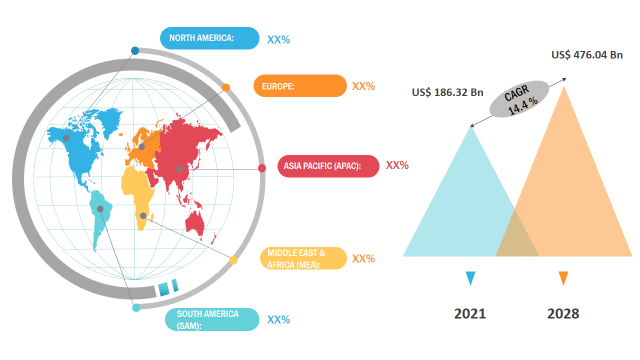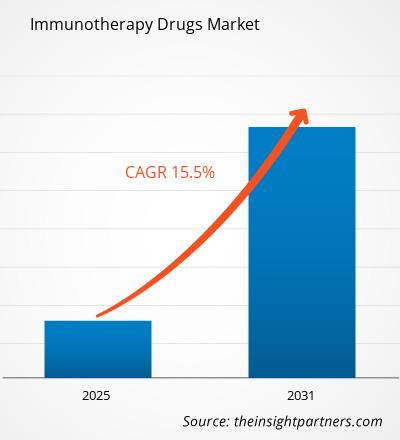免疫療法薬市場は、2021 年に 1,863 億 2,000 万米ドルから成長すると予想されています 2031年までに4,760億4,000万米ドルに。 2022 年から 2031 年にかけて 14.4% の CAGR で成長すると予想されています。
モノクローナル抗体の需要の増加は、免疫療法薬市場。免疫療法で使用されるモノクローナル抗体は細胞クローンから人工的に生成されるため、単一タイプの免疫グロブリンで構成されます。それらは特定の抗原を標的とし、抗原に結合して複合体を形成します。モノクローナル抗体は、がん、関節リウマチ、多発性硬化症、全身性エリテマトーデス、心血管疾患などの疾患の治療に使用できます。 食品医薬品局 (FDA) によると、2021 年までに 450 を超えるモノクローナル抗体が承認されました。2022 年 2 月、FDA はベブテロビマブの緊急使用許可 (EUA) を発行しました。SARS-CoV-2 のミクロン変異体に対して有効なモノクローナル抗体 。この薬は、軽度から中等度の症状がある成人および小児患者、または重症の新型コロナウイルス感染症(COVID-19)への進行リスクが高い患者に効果がありました。
市場のダイナミクス
免疫療法薬市場の成長は主に、対象疾患に対する需要の増加、バイオシミラーやモノクローナル抗体の需要の増加、従来の治療法と比較した免疫療法薬カテゴリーの採用の増加に起因しています。しかし、免疫療法薬の製造に関連する課題が市場の成長を妨げています。さらに、個別化された医療に対する需要の高まりが、予測期間中の免疫療法薬市場の成長を促進します。
戦略的洞察
市場範囲
&ldquo ;2031 年までの世界の免疫療法薬市場分析』レポートは、種類、臨床適応症、エンドユーザーに基づいた詳細な市場分割を含む免疫療法薬市場の概要を提供することを目的としています。このレポートは、主要企業の業績に基づいた主要な市場統計を提供します。また、市場の主要なトレンドと機会も提供します。
市場セグメンテーション
世界の免疫療法薬市場はタイプ別に分割されています。 、臨床適応症、およびエンドユーザー。種類に基づいて、市場はワクチンアジュバント、樹状細胞活性化剤、およびワクチンアジュバントに分類されます。成長因子、T細胞刺激因子、および成長因子、免疫チェックポイント阻害剤、モノクローナル抗体、インターロイキンとインターフェロンなど。適応症に基づいて、市場はがん、炎症性疾患、自己免疫疾患、感染症などに分類されます。エンドユーザーセグメントはさらに病院と医療機関に分類されます。クリニック、外来手術センターなど。
世界の免疫療法薬市場は、北米、ヨーロッパ、アジア太平洋、中東の 5 つの主要地域に分割されています。 &アフリカ、そして南と南。中米。このレポートでは、世界 18 か国の分析と予測、およびこの地域に広がる傾向と機会を取り上げています。
地域的な観点から見ると、北米は 2021 年に最大 40% の市場シェアを獲得して免疫療法薬市場を支配しています。この地域の市場成長は主に次の要因によるものです。 F. Hoffmann-La Roche Ltd.、Pfizer Inc.、Merck & Ltd. などの免疫療法薬メーカーが多数存在します。ノバルティス インターナショナル AG、ジョンソン& カンパニー共同ジョンソン、サノフィ、グラクソスミスクライン Plc.以下の図は、北米の免疫療法薬市場の収益成長傾向を示しています。

< span style="font-family: verdana, Geneva, sans-serif; font-size: 10pt;">出典: Insight Partners 分析
新型コロナウイルス感染症(COVID-19)のパンデミックの影響
新型コロナウイルス感染症の流行により、免疫療法薬の需要が増加し、製薬メーカーからの大量の注文が発生し、生産量が増加しました。生産量の増加により、さまざまな医薬品成分メーカーの製品利益が増加しました。したがって、SARS-CoV-2 の蔓延の初期段階で医薬品成分の調達が増加し、それによって世界の免疫療法薬市場の成長が促進されました。
需要の大部分は、ワクチンアジュバントの製造業者。米国食品医薬品局(FDA)は、ファイザー/ビオンテックとモデルナの新型コロナウイルス感染症(COVID-19)ワクチンの緊急使用許可を与えた。これらの薬は医療専門家によって 16 歳以上の人々に推奨されており、1 回あたり 30 μg (0.3 μg) の用量で、19.50 米ドル かかります。その結果、医薬品の調達が増加し、予測期間中に免疫療法薬市場が強化されるでしょう。
このレポートには、主要な免疫療法薬のプロファイルも含まれています市場企業とその SWOT 分析および市場戦略。さらに、このレポートは、企業概要、提供されるコンポーネントとサービス、過去 3 年間の財務情報、過去 5 年間の主要な開発などの情報を提供する業界の主要企業に焦点を当てています。 免疫療法薬市場に携わる数社のリストを以下に示します。
- •Incyte Corporation•Juno Therapeutics•< span style="font-family: verdana, Geneva, sans-serif; font-size: 10pt;">Celldex Therapeutics•Tesaro, Inc.•F. Hoffmann-La Roche Ltd •Amgen Inc.•ノバルティス AG•BioNTech SE•サノフィ•GlaxoSmithKline Plc•ファイザー株式会社< /span>•Merck &コ•ジョンソン&amp;ジョンソン
Insight Partner の専任の調査分析チームは、経験豊富な専門家で構成されています。高度な統計専門知識を備え、既存の研究にさまざまなカスタマイズ オプションを提供します。
< img style="表示: ブロック; マージン左: 自動; マージン右: 自動;" src="https://www.theinsightpartners.com/assets/rdimages/immunotherapy-drugs-market-img2.png" alt="市場調査" width="350" height="350">
- 過去2年間の分析、基準年、CAGRによる予測(7年間)
- PEST分析とSWOT分析
- 市場規模価値/数量 - 世界、地域、国
- 業界と競争環境
- Excel データセット



Report Coverage
Revenue forecast, Company Analysis, Industry landscape, Growth factors, and Trends

Segment Covered
This text is related
to segments covered.

Regional Scope
North America, Europe, Asia Pacific, Middle East & Africa, South & Central America

Country Scope
This text is related
to country scope.
よくある質問
The report can be delivered in PDF/PPT format; we can also share excel dataset based on the request.
Some of the customization options available based on request are additional 3-5 company profiles and country-specific analysis of 3-5 countries of your choice. Customizations are to be requested/discussed before making final order confirmation, as our team would review the same and check the feasibility.
The leading players in the Immunotherapy Drugs Market are: Incyte Corporation, Juno Therapeutics, Celldex Therapeutics Tesaro, Inc., F. Hoffmann-La Roche Ltd , Amgen Inc., Novartis AG, BioNTech SE, Sanofi, GlaxoSmithKline Plc, Pfizer Inc., Merck & Co, Johnson & Johnson
Immunotherapy Drugs Market is expected to grow at a CAGR of 15.5% between 2023-2031
The future trends of the Immunotherapy Drugs Market are: Personalized Immunotherapy, Combination Therapies
The driving factors impacting the Immunotherapy Drugs Market are: Rising Cancer Prevalence, Advancements in Immunotherapy Research
Trends and growth analysis reports related to Life Sciences : READ MORE..
The List of Companies
1. Eli Lilly and Company
2. Astrazeneca
3. Abbvie
4. Amgen inc
5. GlaxoSmithKline Plc
6. Novartis International AG
7. Merck and Co., Inc
8. F. Hoffmann-La Roche AG
9. Bristol-Myers Squibb
10. UbiVac
The Insight Partners performs research in 4 major stages: Data Collection & Secondary Research, Primary Research, Data Analysis and Data Triangulation & Final Review.
- Data Collection and Secondary Research:
As a market research and consulting firm operating from a decade, we have published and advised several client across the globe. First step for any study will start with an assessment of currently available data and insights from existing reports. Further, historical and current market information is collected from Investor Presentations, Annual Reports, SEC Filings, etc., and other information related to company’s performance and market positioning are gathered from Paid Databases (Factiva, Hoovers, and Reuters) and various other publications available in public domain.
Several associations trade associates, technical forums, institutes, societies and organization are accessed to gain technical as well as market related insights through their publications such as research papers, blogs and press releases related to the studies are referred to get cues about the market. Further, white papers, journals, magazines, and other news articles published in last 3 years are scrutinized and analyzed to understand the current market trends.
- Primary Research:
The primarily interview analysis comprise of data obtained from industry participants interview and answers to survey questions gathered by in-house primary team.
For primary research, interviews are conducted with industry experts/CEOs/Marketing Managers/VPs/Subject Matter Experts from both demand and supply side to get a 360-degree view of the market. The primary team conducts several interviews based on the complexity of the markets to understand the various market trends and dynamics which makes research more credible and precise.
A typical research interview fulfils the following functions:
- Provides first-hand information on the market size, market trends, growth trends, competitive landscape, and outlook
- Validates and strengthens in-house secondary research findings
- Develops the analysis team’s expertise and market understanding
Primary research involves email interactions and telephone interviews for each market, category, segment, and sub-segment across geographies. The participants who typically take part in such a process include, but are not limited to:
- Industry participants: VPs, business development managers, market intelligence managers and national sales managers
- Outside experts: Valuation experts, research analysts and key opinion leaders specializing in the electronics and semiconductor industry.
Below is the breakup of our primary respondents by company, designation, and region:

Once we receive the confirmation from primary research sources or primary respondents, we finalize the base year market estimation and forecast the data as per the macroeconomic and microeconomic factors assessed during data collection.
- Data Analysis:
Once data is validated through both secondary as well as primary respondents, we finalize the market estimations by hypothesis formulation and factor analysis at regional and country level.
- Macro-Economic Factor Analysis:
We analyse macroeconomic indicators such the gross domestic product (GDP), increase in the demand for goods and services across industries, technological advancement, regional economic growth, governmental policies, the influence of COVID-19, PEST analysis, and other aspects. This analysis aids in setting benchmarks for various nations/regions and approximating market splits. Additionally, the general trend of the aforementioned components aid in determining the market's development possibilities.
- Country Level Data:
Various factors that are especially aligned to the country are taken into account to determine the market size for a certain area and country, including the presence of vendors, such as headquarters and offices, the country's GDP, demand patterns, and industry growth. To comprehend the market dynamics for the nation, a number of growth variables, inhibitors, application areas, and current market trends are researched. The aforementioned elements aid in determining the country's overall market's growth potential.
- Company Profile:
The “Table of Contents” is formulated by listing and analyzing more than 25 - 30 companies operating in the market ecosystem across geographies. However, we profile only 10 companies as a standard practice in our syndicate reports. These 10 companies comprise leading, emerging, and regional players. Nonetheless, our analysis is not restricted to the 10 listed companies, we also analyze other companies present in the market to develop a holistic view and understand the prevailing trends. The “Company Profiles” section in the report covers key facts, business description, products & services, financial information, SWOT analysis, and key developments. The financial information presented is extracted from the annual reports and official documents of the publicly listed companies. Upon collecting the information for the sections of respective companies, we verify them via various primary sources and then compile the data in respective company profiles. The company level information helps us in deriving the base number as well as in forecasting the market size.
- Developing Base Number:
Aggregation of sales statistics (2020-2022) and macro-economic factor, and other secondary and primary research insights are utilized to arrive at base number and related market shares for 2022. The data gaps are identified in this step and relevant market data is analyzed, collected from paid primary interviews or databases. On finalizing the base year market size, forecasts are developed on the basis of macro-economic, industry and market growth factors and company level analysis.
- Data Triangulation and Final Review:
The market findings and base year market size calculations are validated from supply as well as demand side. Demand side validations are based on macro-economic factor analysis and benchmarks for respective regions and countries. In case of supply side validations, revenues of major companies are estimated (in case not available) based on industry benchmark, approximate number of employees, product portfolio, and primary interviews revenues are gathered. Further revenue from target product/service segment is assessed to avoid overshooting of market statistics. In case of heavy deviations between supply and demand side values, all thes steps are repeated to achieve synchronization.
We follow an iterative model, wherein we share our research findings with Subject Matter Experts (SME’s) and Key Opinion Leaders (KOLs) until consensus view of the market is not formulated – this model negates any drastic deviation in the opinions of experts. Only validated and universally acceptable research findings are quoted in our reports.
We have important check points that we use to validate our research findings – which we call – data triangulation, where we validate the information, we generate from secondary sources with primary interviews and then we re-validate with our internal data bases and Subject matter experts. This comprehensive model enables us to deliver high quality, reliable data in shortest possible time.

 このレポートの無料サンプルを入手する
このレポートの無料サンプルを入手する